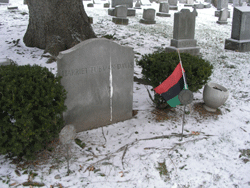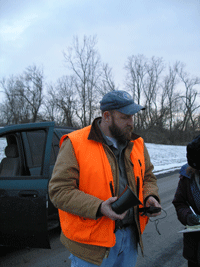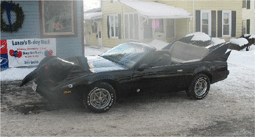Urban Crow Invasion
Air Date: Week of January 20, 2006

Crow droppings mar the gravestone of Underground Railroad heroine Harriet Tubman. (Photo: Sy Montgomery)
Each winter Auburn, New York is invaded by hundreds of thousands of crows. No one knows exactly why the birds come to this small city upstate, but the scene they create – and the mess – has residents divided over whether to embrace the crows or drive them out. Sy Montgomery reports on efforts currently underway by pro-crow and anti-crow forces.
Transcript
[CROW SOUNDS]
CURWOOD: Imagine coming home from work at the end of a long day and all of a sudden you look up in the sky and see a huge, dark cloud approaching.
McGOWAN: You start to see lines of crows coming from three or four different directions. It looks almost like they are leaves on the trees; but they are big and black and they make noise.
CURWOOD: At times they’re so many crows they seem uncountable.
LATTIMORE: They’re so thick, it’s almost like out of the movie “The Birds.”
CURWOOD: But for citizens of Auburn, New York, the avian invasion isn’t Hollywood fiction – each winter it’s a daily reality show.
LATTIMORE: It’s a gigantic black explosion – the noise, the beauty of the whole thing, it was beautiful. If that was on television I’d watch it. I’d love that.
CURWOOD: Sy Montgomery reports on a city inundated with crows, and its residents divided over whether the birds are a blessing or a curse.
MONTGOMERY: Auburn is a small city. A city of fine old churches and pretty little parks located about 25 miles southwest of Syracuse, as the crow flies. And each winter, a lot of crows do fly to this community of 28,000 people. Tens of thousands of them.

Crow droppings mar the gravestone of Underground Railroad heroine Harriet Tubman. (Photo: Sy Montgomery)
MONTGOMERY: The spectacle begins around dusk: a river of black wings, the air alive with noisy, hurrying birds flowing down from the sky. No one knows exactly why crows mass in the winter. Ornithologists think they do it to share information, or ward off predators with sheer numbers. Whatever the reason, crows have been roosting in Auburn for at least 100 years. They used to keep to the outskirts, but lately they’ve been coming downtown. Maybe it’s the fine dining.
LATTIMORE: They know our trash routes better than our sanitation department!
MONTGOMERY: That’s Auburn’s Mayor, Tim Lattimore. When he took office, downtown Auburn’s crow roost was the biggest in the state. Last winter, biologists counted 63,000 of them. In Auburn, in winter, crows are the talk of the town. Some folks welcome them; others are intimidated by so many black birds. But on one point, most agree: tens of thousands of crows can leave your city in, well, deep doo-doo.

Mayor Tim Lattimore has paid the USDA to scare crows from the city. (Photo: Rachel Gotbaum)
MONTGOMERY: Though experts assure the birds pose no threat of transmitting, say, bird flu, the crows do present the mayor with a big public relations problem.
LATTIMORE: I’m trying to attract Fortune 500 companies, and with the droppings that the birds were giving, people would walk in City Hall with fecal matter on their feet. It’s just not cleanly. It just doesn’t give the right presentation that we want to give off here in the city of Auburn.
MONTGOMERY: So he called in the U.S. Department of Agriculture’s Wildlife Services Program. Biologist Rich Chipman is the New York state director.

USDA biologist Rich Chipman prepares to go out with teams for crow harassment. (Photo: Rachel Gotbaum)
MONTGOMERY: For a week, Chipman and eight federal scientists team up with eight city employees, including Dave “Spider” Ganey, who’s been working Auburn’s streets for 35 years.
SPIDER: VanAnden Street? Give us two minutes. We’re about two minutes away from there.
MONTGOMERY: Wearing blaze orange vests and driving trucks boldly labeled USDA Wildlife Services, these men are on a mission: to drive as many crows out of town as they can.
[TRAVEL SOUNDS]
MONTGOMERY: Tonight, we head for one of the birds’ favorite spots, a neighborhood of tall pines and oaks, not far from a ball field.
CHIPMAN: This is prime time, about 6 o clock, when we would certainly expect to see crows trying to roost here for the night.
MONTGOMERY: The team’s arsenal is completely non-lethal, but effective:
[CROW DISTRESS CALL]
MONTGOMERY: A tape recording of a crow distress call broadcasts the news that this is no place to spend the night. Shining a bright red laser into the trees makes the crows nervous. Pretty soon, the flock gets the message:
[SOUNDS OF FLYING AND WINGS WITH RECORDED DISTRESS CALL IN BACKGROUND]
MONTGOMERY: As thousands of crows flee the trees, their wing beats sound like a rainstorm, and their deep black forms against the gray sky look like night itself taking flight.
[SOUNDS OF FLYING AND WINGS WITH RECORDED DISTRESS CALL IN BACKGROUND]
MONTGOMERY: Each night, teams try to hit all the crow hotspots, like a little park on the west side of town.
CHIPMAN: Here, along the back of the bench, you can see whitewash. These are all crow droppings, and it’s really impacted people’s ability to enjoy the area.
SPIDER: I work for the city, I see it all the time. The parking meters were so bad you couldn’t even put money in them, they’d be dripping with this.
MONTGOMERY: But in the grove of trees where the birds typically roost, we find none tonight. This is the fifth night of the program, and these extremely intelligent birds are learning fast. If they don’t leave things will only get worse.
SPIDER: Do you have your artillery rounds, Rich? I’ve got some caps left.
[SOUND OF CAPS AND GETTING OUT CAR.]
[SOUNDS OF GETTING PYRO READY FOR A FEW SECONDS IN TRUCK]
MONTGOMERY: For stubborn crows, Chipman and Spider break out the heavy stuff.
[PYRO SHOOTS OFF]
MONTGOMERY: Screaming rockets shot off from a cap gun zig zag into the night air.
CHIPMAN: Put the laser through here and we’re gonna do the pyrotechnic again.
[MORE PYRO SOUNDS]
MONTGOMERY: Near the maximum-security prison, usually a favored spot, one lone crow eyes the USDA truck suspiciously from the top of a tall tree.
CHIPMAN: Quite often before they roost they’ll send in a sentinel or a scout to make sure things are OK, and you can see this guy is looking and he’s obviously a little nervous. See how he’s bobbing back and forth? He may go back and send a message that this isn’t the place to go for tonight. They actually communicate back and forth quite a bit.
MONTGOMERY: Word’s apparently spreading in Crowdom. So far, 90 percent of the 36,000 crows that showed up this year are gone. After seven days and 14,000 city dollars, downtown Auburn is no longer crow city.
[BAR AMBIANCE]
MONTGOMERY: But over at the J&B Bar and Grill, Tom Lennox and his buddies have a message for the USDA team. Just moving crows around is a waste of time.
LENNOX: What they don’t understand - America - hunting is a tradition.
MONTGOMERY: Lennox calls crows feathered rats, and he’s made the bar the official headquarters for this year’s Crow Shoot, scheduled for the second weekend in February. Shooting crows in winter is perfectly legal in rural New York. Lennox and his friends have been doing it for years. They even award cash prizes for the team of hunters who kill the most crows in one day. Lennox sees it as a way to liven up the winter.
LENNOX: Well, if you don’t ice fish and you don’t snowmobile, and the Super Bowl’s over with, NASCAR doesn’t start for another week…what are a bunch of rednecks like me supposed to do? So, we all just basically got together…(laughs)
MONTGOMERY: Kidding aside, Lennox says last year more than 200 people came here, from as far away as Arizona. The teams killed about a thousand crows in all. Profits from the hunt were donated to a needy local individual, and the hunters gave a Cornell ornithologist more crow carcasses than he could study. But not everybody thinks the Crow Shoot is a great idea.

Dead crows are strung up in trees in one Auburn resident’s yard. (Photo: Sy Montgomery)
MONTGOMERY: When Rita Sarnicola heard about the shoot she formed CROW: Citizens Respectful of Wildlife. The group urges people to celebrate the urban crow roost – to appreciate the birds as living creatures, and to use them as a cultural resource instead of for target practice.
SARNICOLA: Oh my goodness, the potential is just enormous. We could have tourists come in from other cities. Even the children’s groups could come in from our local areas. We could have it as a science study. There are so many people that love nature-watching, and this is such a unique phenomena it would just bring in tourists. And it would also stimulate a lot more businesses downtown, too, and we could have a lot of fun with it. It could be like a “Crows R’ Us” type of city.

Crow Shoot organizer Tom Lennox’s Crowmobile, a customized 1986 Pontiac, with wings and a system that dispenses “crow poop” (actually, a mixture of Cremor and windshield wiper fluid). (Courtesy of Tom Lennox).
NELSON [READING]:
“…And Someone driving west through town is amazed
at the swirl of the flock across the winter sky…”
MONTGOMERY: Cayuga County Community College English professor Howard Nelson was among the authors who read at the event:
NELSON [READING]:
“Wow, a natural wonder, he thinks
The most beautiful thing he’s ever seen in the city, or maybe anywhere,
And feels it’s a piece of luck to have crows in your city
Something to be grateful for,
To share the wintry earth with crows.”
MONTGOMERY: And how should we share the wintry earth with crows? That’s a question Auburn crow chaser Dave "Spider" Ganey never used to think about.
SPIDER: I think I kind of thought like a lot of other people did, that they were just flying rats, you know?
MONTGOMERY: But now – after being in the unique position to watch crows a lot more than the average citizen of Auburn - Spider says he’s changed his mind.
SPIDER: I appreciate them a lot more than I ever did before. I find them incredibly intelligent, versatile. I’m pretty much fascinated by the whole project, how these fellas do it. It’s been a great learning experience.
MONTGOMERY: And obviously, something to crow about. For Living on Earth, I’m Sy Montgomery in Auburn, New York.
CURWOOD: For a bird’s eye view of this story, go to our website, Livingonearth.org. Our story was produced by Rachel Gottbaum.
Links
**LOE Web-only Special: Reporter Sy Montgomery talks with crow expert Kevin Mcgowen of Cornell Laboratory of Ornithology 

Living on Earth wants to hear from you!
Living on Earth
62 Calef Highway, Suite 212
Lee, NH 03861
Telephone: 617-287-4121
E-mail: comments@loe.org
Newsletter [Click here]
Donate to Living on Earth!
Living on Earth is an independent media program and relies entirely on contributions from listeners and institutions supporting public service. Please donate now to preserve an independent environmental voice.
NewsletterLiving on Earth offers a weekly delivery of the show's rundown to your mailbox. Sign up for our newsletter today!
 Sailors For The Sea: Be the change you want to sea.
Sailors For The Sea: Be the change you want to sea.
 The Grantham Foundation for the Protection of the Environment: Committed to protecting and improving the health of the global environment.
The Grantham Foundation for the Protection of the Environment: Committed to protecting and improving the health of the global environment.
 Contribute to Living on Earth and receive, as our gift to you, an archival print of one of Mark Seth Lender's extraordinary wildlife photographs. Follow the link to see Mark's current collection of photographs.
Contribute to Living on Earth and receive, as our gift to you, an archival print of one of Mark Seth Lender's extraordinary wildlife photographs. Follow the link to see Mark's current collection of photographs.
 Buy a signed copy of Mark Seth Lender's book Smeagull the Seagull & support Living on Earth
Buy a signed copy of Mark Seth Lender's book Smeagull the Seagull & support Living on Earth

